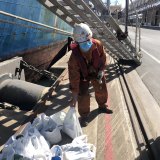This week I was granted permission to enter the port of Portland – locked to the public, like all such international shipping hubs, since the twin towers in New York fell to jets hijacked by terrorists in September 2001.
There on the wharf was the latest Mission to Seafarers, a converted office building barely 80 metres from the nearest ship’s berth.

Neville Manson stocks everything from food, doonas and beanies to souvenirs and reading matter for seamen making brief stops in Portland. But for months now they have been unable to set foot in the Mission to Seafarers.Credit:Tony Wright
There were racks of chocolate bars and shelves of soft drinks; a library; stands of souvenirs; couches for relaxing; toothbrushes and toiletry essentials. A door opened to a games room with table-tennis tables and a basketball hoop.
But nobody stirred its silence. Not a single seafarer has been permitted since the end of January 2020, more than 13 months ago, to walk the few metres from a moored ship to the mission, set up as a club for those seeking respite from the drudgery and loneliness of shipboard life.
The era of the pandemic has become something even more grim than the era of terrorism for the world’s ports and seagoers. It has become a lockdown without end for hundreds of thousands of ships’ crew members across the world.
Australia earns its wealth by shipping natural and agricultural products to international markets and we purchase from overseas much of what we consume, from cars to just about everything in our department stores.
But those who work the ships that facilitate this mighty exchange have been cast adrift on the oceans and exist as ghosts in port, unable to leave the vessels on which they labour.
Loading
They can look at the land and the wharf from the deck and the portholes of their ships, but health and border authorities deem them too great a risk to be allowed to set foot ashore.
Many seafarers who signed on for a standard nine-month contract in early 2019 have not seen their families or homes since, and few have any idea when their misery might end, for crew changes have become next to impossible.
These are no luxury cruises.
The International Labour Organisation puts the minimum monthly wage for able seafarers at $US614 ($718) a month, which at a standard 260 hours of work, comes to a bit less than $2.80 an hour.
Most have their pay wired home, not knowing when they might see their families again.
“Many of these people on the ships are suffering serious mental problems,” says the manager of Portland’s Mission to Seafarers, Neville Manson, fretting that even the mercy of an hour’s stress release at his mission is denied the crews.
He worries about the stories of suicides and mysterious disappearances at sea.
He is not alone. The international maritime intelligence authority, Lloyd’s List, reported last month that despite anecdotal evidence that suicides on the high seas had risen during 2020, there was no central database to count the toll.
Manson looks around his empty mission, which receives no funding from any level of government.
“All the perishables here are going out of date, so before that happens, we put them in comfort packs and supply them for free to those trapped on the ships,” he says.
He bundles chocolate bars, drinks, toothpaste, soap, deodorant and woollen beanies into numerous plastic bags. Beanies, he says, are wildly popular among seafarers who must face wild and often freezing weather.
Often he receives text messages from crew or their families asking him to shop for essentials in the town that seafarers were once free to wander, but which is now forbidden territory.
We drive to a bulk carrier tied to the wharf nearby, where Manson deposits 23 little comfort packs – 23 being the average number of crew on a merchant ship – at the foot of the gangway.

Chen Chen from China retrieves Neville Manson’s 23 comfort packages from the foot of the gangplank in Portland. Credit:Tony Wright
He steps back, signals to the seamen on deck above and one of them scuttles down to retrieve the gifts, bowing his thanks.
I call for his name and he says he is Chen Chen, from China. Then he is gone, ghosting up the gangway, his brief near-contact with the wharf over.
If those seamen who came to our table years ago were lonely, I reflect, many of today’s seaborne crews must be desolate beyond measure.
Donations to the Portland Mission to Seafarers can be made here.
Tony Wright is the associate editor and special writer for The Age and The Sydney Morning Herald.
Most Viewed in National
Loading






